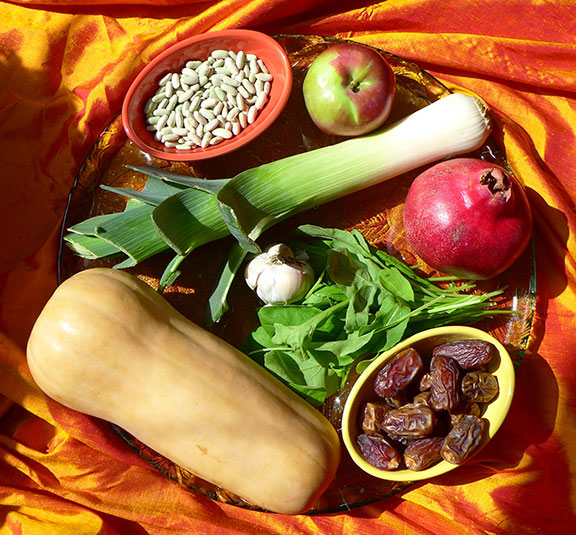Did you know that in some Sephardic homes there is the custom of presenting a special Seder plate before the Rosh HaShanna meal, just like one does for the Passover Seder? Eight symbolic foods (Simanim) are selected and arranged on a platter to ensure a happy, healthy, and prosperous new year, and while certain ones may physically represent an idea (such as using pomegranates to symbolize fertility and abundance because of the many seeds within), another less obvious food choice may be made simply because its name in Hebrew sounds like another Hebrew word with a different meaning (for example: using a leek because its Hebrew word karati sounds like karat meaning “to cut off,” implying the hope of breaking away from one’s enemies). Below is a quick guideline or listing of the types of things often used on a Rosh Hashanna Seder plate:
For the New Year, we eat foods that symbolize the following:
Luck
Abundance (foods that are plentiful)
Mitzvot (good deeds)
Fertility, Life (foods that are round, continuous, plentiful)
Leadership
The act of breaking away from evil, enemies and bad things
VARIOUS FOODS USED TO REPRESENT THE FOLLOWING IDEAS:
happiness, prosperity, good luck and success:
Aniseed, round challah with raisins added, sweet wine, stuffed foods like gefilte fish, tzimmes (sweet stew: carrot, sweet potatoes, prunes, raisins, sometimes meat)
fertility:
Apples, pears (first fruits of season from the tree, dipped in honey, sugar, or sesame seeds for abundance and extra sweetness)
good deeds (mitzvot) and abundance:
Pomegranate seeds (belief that there are as many seeds — 613, as there are mitzvot)
peace:
Dates (Hebrew word for date is tamar and is related to word tam meaning, “to end” in hopes that our enemies will end)
happiness: Gourd, pumpkin, butternut or acorn squash (Hebrew word for gourd is kara, which also means “to announce,” and rhymes with a similar sounding word meaning “to rip apart”)
freedom: Spinach, collard greens, Swiss chard, kale, beet leaves (Hebrew word for beets is seleka and related to root selek meaning, “to depart” or “remove” implying that enemies and bad luck be taken out; Aramaic word for leafy green, like spinach, is silka)
friendship, freedom from enemies: Leeks, chives, scallions, spring onions (Hebrew word for leek is karati and sounds like karat meaning “to cut off,” implying from one’s enemies)
leadership: Whole Fish (with head left intact), ram’s head, head of cabbage, garlic (“Head” of year, leaders to all nations, poor and powerless, move forward/ahead/progress)
commemorating tribulations, difficulties, struggles, and hardships of past year:
Savory and bitter foods
prosperity: String beans, peas, beans (plentiful, abundant, round/circle of life) (Hebrew word for beans is lubia, sounds related to Hebrew word lev meaning “heart,” and rav meaning “many”)
NOTE: Some refrain from eating lemon or salt fearing that it will bring bad luck in coming year.


Very interesting post!
What an interesting post on how to make Rosh Hashanah even more meaningful. I love learning others traditions and the foods that people have used to represent the past, present and future. I can now be more creative through the foods that I choose to eat, serve or have on hand at our celebrations (We used to use the whole fish/fish head, but I definitely like using a cabbage better!). It’s especially helpful since I just hosted my first Rosh Hashanah dinner!
Thank you and Shana Tova!
Thank you Andrea! Shana Tova Metuka to you and all of my readers out there!